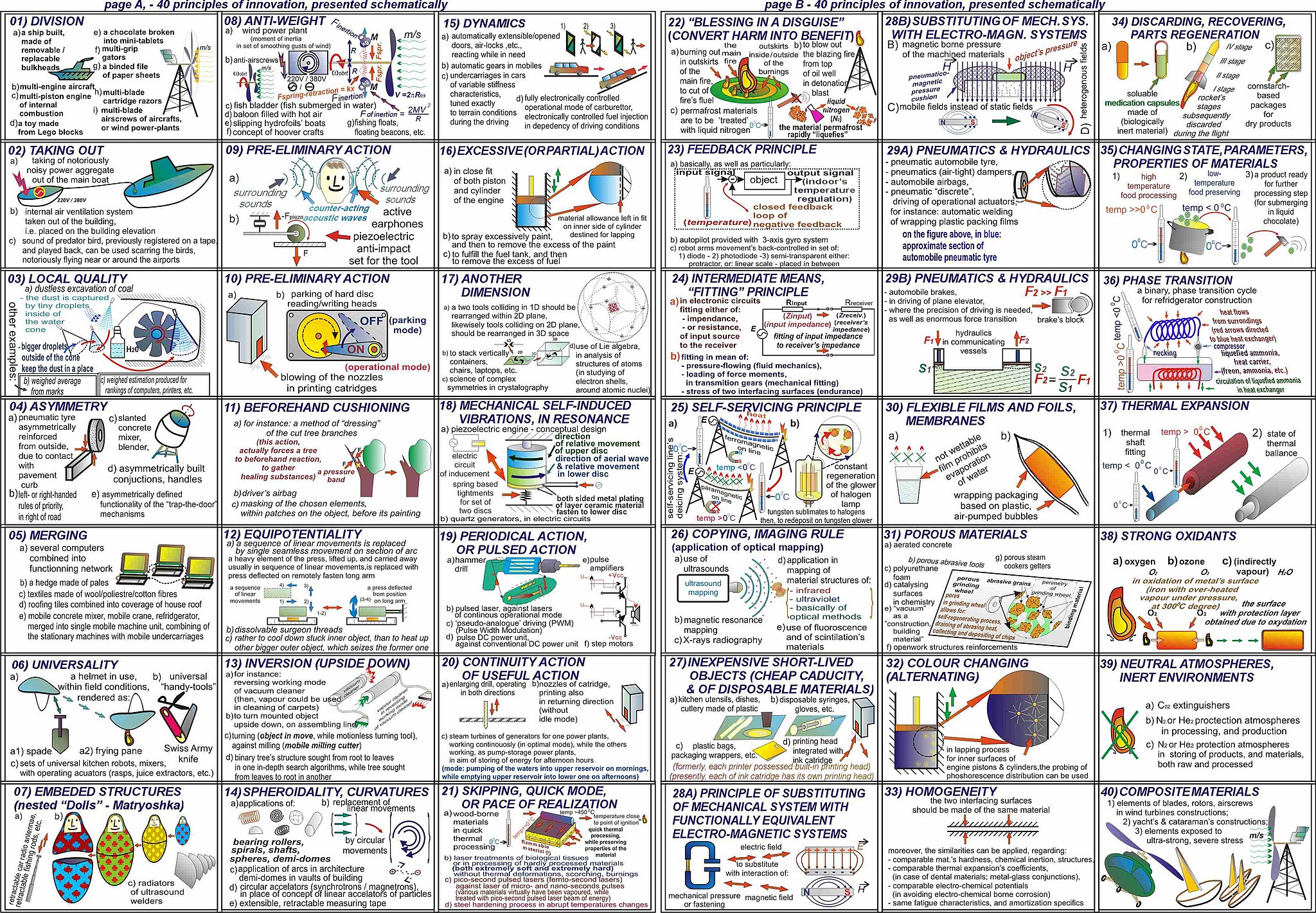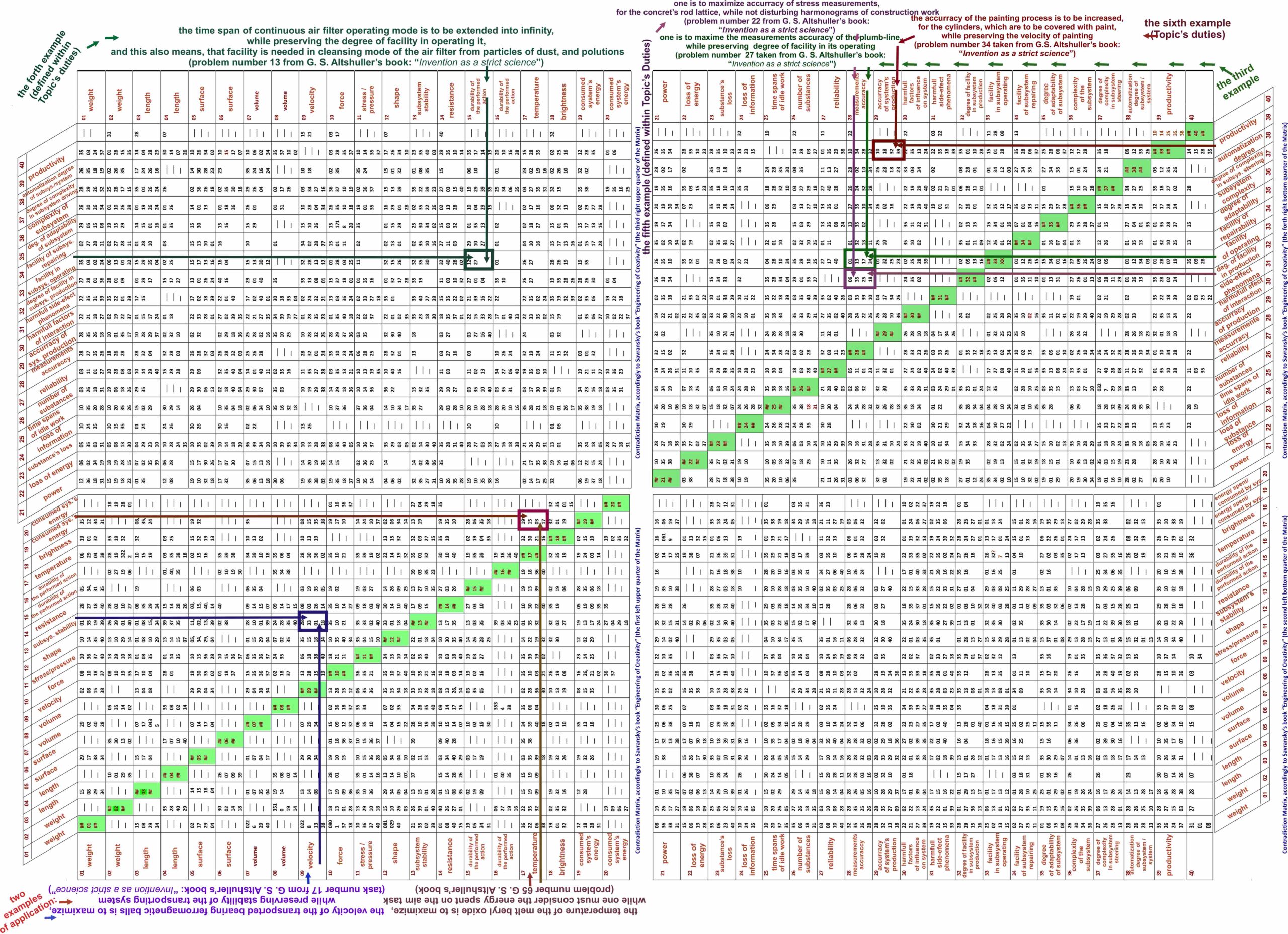40 inventive principles are a selection of conceptual solutions to technical and physical contradictions (Savransky, 2000, pp. 204–221; Altshuller et al., 1989, pp. 285–292). These principles are used together with the contradiction matrix for a solution search (see the matrix at the bottom of the post).
A brief introduction about the origin of TRIZ and these principles as a part of the story can help seeing it as a part of a bigger picture. In short, the observation of most common inventive solutions has helped structuring those solutions in a form of 40 standard inventive principles of TRIZ. In order to be able to use them, one needs to define the technical contradiction pairs. Once the pairs are defined, the TRIZ contradiction matrix presented in below helps finding the proposed solution path. The contradiction matrix is available in free access online (for example, SolidCreativity, 2024b; Hipple, 2012, p. 193) with explanations how the principles work (for instance, Hipple, 2012, pp. 105–112).

Here, I also list the 40 inventive principles with their brief of concept (Bukhman, 2021, pp. 93–123; Savransky, 2000, pp. 251–266):
1. Segmentation: Breaking a system into smaller parts to make it simpler and more manageable.
2. Taking Out: Removing a component or a feature to simplify the system.
3. Local Quality: Improving the quality of a specific part of a system to achieve overall improvement.
4. Asymmetry: Creating an asymmetrical design to resolve conflicts and improve performance.
5. Merging: Combining two or more components or functions into one.
6. Universality: Designing a system to perform multiple functions.
7. Nesting (nested doll): Embedding one component or system within another.
8. Counterweight: Balancing opposing forces in a system to reduce stress and increase stability.
9. Preliminary Action: Preparing for a future action to make it easier and more effective.
10. Beforehand Cushioning: Anticipating and protecting against future stress, shocks or impacts.
11. Equipotentiality: Designing a system to perform equally well under different conditions.
12. Inversion: Reversing the direction of an action to solve a problem.
13. Rolling: Replacing sliding or linear motion with rolling motion to reduce friction and wear.
14. Partial or Excessive Actions: Using partial or excessive actions to overcome limitations.
15. Another Dimension: Adding another dimension to a system to improve its performance.
16. Parameter Changes: Changing the parameters of a system, such as temperature, pressure, or frequency, to solve a problem.
17. Dynamics: Making a system dynamic to improve its performance and efficiency.
18. Coming and Going: Alternating the direction of an action to solve a problem.
19. Feedback: Using feedback to control and optimize the performance of a system.
20. Intermediary: Using an intermediary component or process to improve the performance of a system.
21. Self-Service: Designing a system to perform tasks automatically without human intervention.
22. Copying: Replicating an effective solution to solve a similar problem.
23. Composites: Combining different materials or components to achieve desired properties.
24. Distribution: Distributing a function or load over multiple components to reduce stress and improve performance.
25. Repair: Designing a system to be easily repairable.
26. Improvised Means: Using improvised or makeshift means to solve a problem temporarily.
27. Artificial Materials and Objects: Creating artificial materials and objects with desired properties.
28. Transformations: Transforming one substance into another to solve a problem.
29. Orthogonal Arrangement: Aligning components or systems at 90-degree angles to improve stability and performance.
30. Phase Transitions: Using phase transitions, such as melting or vaporization, to solve a problem.
31. Weaknesses, Balls and Reinforcements: Strengthening weak points in a system to improve its performance.
32. Interaction with the Environment: Using the environment to improve the performance of a system.
33. Self-Similarity: Creating self-similar patterns to simplify the system and improve performance.
34. Spheroidality: Using spherical shapes to improve the stability and performance of a system.
35. Structural Changes: Making structural changes to a system to improve its performance.
36. Piezoelectric Effect: Using the piezoelectric effect, the conversion of mechanical stress to electrical energy, to solve a problem.
37. Phase Conjugation: Using phase conjugation, the reversal of the phase of a wave, to improve the performance of a system.
38. Thermal Expansion: Using the expansion and contraction of materials due to changes in temperature to solve a problem.
39. Combination of Effects: Combining multiple effects to achieve desired results.
40. Cortical Subsystems: Creating subsystems with specific functions to improve the performance of a system.

References
Bukhman, I. (2021). Technology for Innovation. How to Create New Systems, Develop Existing Systems and Solve Related Problems. Singapore: Springer Singapore. 527 p.
Hipple, J. (2012). The Ideal Result: What It Is and How to Achieve It. New York, NY: Springer New York, NY. 192 p.
Savransky, S. D. (2000). Engineering of Creativity. Introduction to TRIZ Methodology of Inventive Problem Solving. First edition. Boca Raton, FL: CRC Press. 408 p.
SolidCreativity. (2024). TRIZ Contradictions Matrix [Web Document]. TRIZ 40. Retrieved October 17, 2024, from https://www.triz40.com/aff_Matrix_TRIZ.php